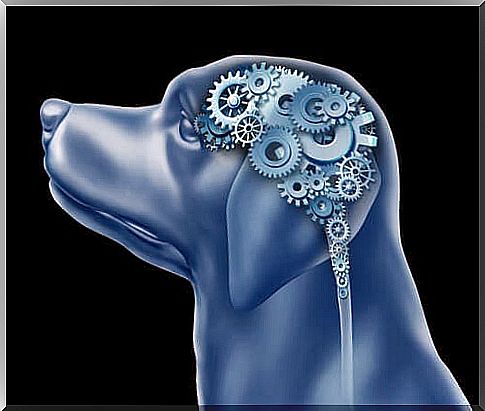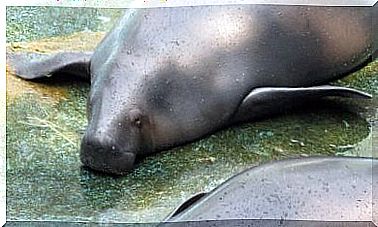The Dogs’ Memory: How Do They Know When It’s Time To Eat?

To date, there is no scientific evidence that dogs can tell what time it is. It is possible that this is because researchers have only started investigating this matter very recently. Many of us who have pets can say that dogs have memories and know when it’s time to eat, and that they also know how to count.
Since time is a human invention, at least the way we usually think about it, in terms of seconds, minutes and hours, the question arises: Can dogs or other animals really understand time in a way similar to ours?
What is envisioned by science?
When studying cognitive memory in other animals, scientists look at two aspects of long-term memory : implicit and declarative memory.
In humans, the implicit memory is sometimes called muscle memory. Through this process, information that is used unknowingly is stored. Once we learn to ride a bicycle, tie our shoes, or play the piano, we can remember these actions without having to think about them.
Declarative or explicit memory stores information about events that happen or things we learn throughout life. Thus, it is made up of personal experiences.
Until recently, declarative memory was considered an exclusively human characteristic, as it allows us to voluntarily bring to consciousness episodes or events from our lives. Thanks to declarative memory, we can relive experiences that happened a long time ago and tell or write the story of our lives.

There are two subtypes of declarative memory
1. Semantic memory
Semantic memory refers to the reserve of all knowledge that we can explicitly evoke that has nothing to do with our own memories.
Some examples of semantic memory are: understanding abstract concepts such as mathematics, knowing historical facts or recognizing objects. It is a personal database with knowledge about the world that we can voluntarily evoke.
2. Episodic memory
Memory under this classification is that which allows a person to recall past personal events or experiences. The information evoked includes what was happening, or where and when it happened. This memory requires the subject to deal with three elements:
- The feeling of subjective time.
- The awareness of this subjective time.
- The notion of an ‘I’ that can be located along subjective time.
Science accepts that autobiographical memory can be considered a kind of time machine that allows consciousness to voluntarily take a mental trip to the evoked moment. In this process, it is possible to re-visit and experience episodes from the past.

animal memory
One of the tests that researchers of undomesticated animals have focused on is that of episodic memory. It is tested whether the animal has the ability to recall past moments to know how to respond in the present.
Thus, it was possible to see that dogs and other animals have implicit memories. These memories are used for learning by trial and error or for conditioned responses. Currently, there is still some uncertainty as to the existence or not of declarative memory in non-human animals.
What does the scientific evidence say?
Scientists have studied episodic memory in monkeys, rats, bees and some birds, including crows. This episodic memory would give them the ability to remember the basic facts about an event: what, where and when. The test scheme for each animal is quite simple.
Let’s say you give a chimpanzee two opaque sealed jars, each with a treat. One of the jars contains a snack that doesn’t spoil, like a grape, for example. While the other contains a treat that must be consumed within a certain period of time, such as a cube of frozen juice that will melt.

After five minutes, the chimpanzee has the opportunity to open one of the vials. After an hour, he can open the other one. Once the test has been applied several times, the most creatures will first open the bottle containing the reward disappears.
So they have learned through experience that if they wait too long, it will no longer be available. These animals also proved to know the three words : ‘what’ (a tasty treat); ‘where’ (inside the bottle); and ‘when’ (within five minutes or so it will no longer be available).
in case of your dog
There is a lot of evidence to suggest that dogs remember people, as their owner, and events, such as going to the park. However, the question remains open as to whether or not they are able to time travel inside their minds.
That’s because man’s best friend has been sadly overlooked when it comes to laboratory experiments. So is it possible for dogs to know what time it is? Maybe, but we don’t really know. However, there are some interesting ideas on how they could do this.

There are some hypotheses, without scientific evidence, to explain your pet’s eating behavior.
1. The circadian rhythm
Dogs have an internal sense that tells them when to sleep or when to be active. Perhaps it is their bodies, not their minds, that can detect approximately what time it is. So, if your dog is used to eating mid-afternoon, his body will be hungry at that time, cyclically.
2. Study the environment
It is known that some animals can read environmental signals. Perhaps dogs use the length of shadows to find the time of day. It has also been suggested that dogs can use their developed sense of smell to detect how much time has passed since an event has occurred, because of the gradual diminishment of a particular smell.
For now, we’ll have to wait a while to find out if, in addition to all the company provided by our dogs, we’ll also be able to ask them what time it is.









